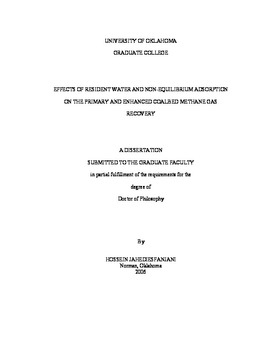| dc.contributor.advisor | Civan, Faruk, | en_US |
| dc.contributor.author | Jahediesfanjani, Hossein. | en_US |
| dc.date.accessioned | 2013-08-16T12:20:08Z | |
| dc.date.available | 2013-08-16T12:20:08Z | |
| dc.date.issued | 2006 | en_US |
| dc.identifier.uri | https://hdl.handle.net/11244/1037 | |
| dc.description.abstract | This study presents an experimental and theoretical procedure to investigate the effects of the resident water and time-dependency of the sorption process on coalbed and shale gas primary and enhanced recovery by simultaneous CO 2/N2 injection. Series of the experiments are conducted to construct both equilibrium and non-equilibrium single and multi-component isotherms with the presence of water. A novel and rapid data interpretation technique is developed based on the nonequilibrium adsorption/desorption thermodynamics, mass conservation law, and volume filling adsorption theory. The developed technique is implemented to construct both equilibrium and non-equilibrium multi-component multi-phase isotherms from the early time experimental measurements. The non-equilibrium isotherms are incorporated in the coalbed methane/shale gas reservoir simulations to account for the time-dependency of the sorption process. | en_US |
| dc.description.abstract | The major part of the gas in coalbed methane and shale gas reservoirs is stored as the adsorbed gas in the coal and organic materials of the black shale internal surfaces. The sorption sites in both reservoirs are composed of several macropores that contain very small pore sizes. Therefore, the adsorption/desorption is very slow process and follows a non-equilibrium trend. The time-dependency of the sorption process is further affected by the reservoir resident water. Water can diffuse into the matrix and adsorption sites, plug the pores and affect the reservoir gas production. | en_US |
| dc.description.abstract | The experimental results indicate that the presence of water in the sorption system reduces both carbon dioxide and nitrogen adsorption rates. Reduction in the adsorption rate for carbon dioxide is more than nitrogen. The results also indicate that the resident water reduces the adsorption ability of low rank coals more than high rank ones. The results of the multi-component sorption tests indicate that increasing the initial mole fraction of the nitrogen gas in the injected CO2/N2 mixture will increase the net carbon dioxide sequestration rate on coals in the presence of water. The optimum CO2/N2 ratio that can result in the maximum carbon dioxide sequestration rate can be obtained by conducting the experiments for various CO2/N2 ratios. | en_US |
| dc.description.abstract | The results of applying the developed non-equilibrium interpretation technique for several literature and in-house data indicate that both the equilibrium and non-equilibrium isotherms can be constructed in shorter time period (around 70 times less than the time required with the equilibrium techniques) and with higher accuracy using this method. (Abstract shortened by UMI.) | en_US |
| dc.format.extent | xix, 297 leaves : | en_US |
| dc.subject | Shale oils. | en_US |
| dc.subject | Engineering, Petroleum. | en_US |
| dc.subject | Energy. | en_US |
| dc.subject | Coalbed methane. | en_US |
| dc.subject | Adsorption. | en_US |
| dc.title | Effects of resident water and non-equilibrium adsorption on the primary and enhanced coalbed methane gas recovery. | en_US |
| dc.type | Thesis | en_US |
| dc.thesis.degree | Ph.D. | en_US |
| dc.thesis.degreeDiscipline | Mewbourne School of Petroleum and Geological Engineering | en_US |
| dc.note | Source: Dissertation Abstracts International, Volume: 67-03, Section: B, page: 1681. | en_US |
| dc.note | Adviser: Faruk Civan. | en_US |
| ou.identifier | (UMI)AAI3212014 | en_US |
| ou.group | Mewbourne College of Earth and Energy::Mewbourne School of Petroleum and Geological Engineering | |
